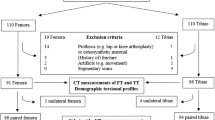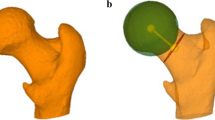Abstract
Objective
The aim of our study was to evaluate the reliability and interchangeability of femoral (FT) and tibial torsion (TT) measurements in children using magnetic resonance (MR) imaging compared to measurements on 3D models based on biplanar radiographs (BPR).
Materials and methods
FT and TT were measured in 60 children (mean age 10.1 years; range 6.2–16.2 years; 28 female) using axial MR images by two readers. MR measurements were compared to measurements based on BPR-3D models by two separate independent readers. Interreader and intermethod agreements were calculated using descriptive statistics, the intraclass correlation coefficient (ICC), and Bland-Altman analysis.
Results
FT/TT was −8.4°–54.1°/0°–45.9° on MR images and −13°–63°/4°–52° for measurements on BPR-3D models. The median of difference between the two methods was −0.18° (range −13.6°–19.1°) for FT and −0.20° (range −18.4°–9.5°) for TT, respectively. Interreader agreement (ICC) of FT/TT measurements was 0.98/0.96 on MR images and 0.98/0.94 on BPR 3D models. Intermethod agreement (ICC) for MR measurements was 0.95 [95% confidence interval (CI), 0.93–0.96] for FT and of 0.86 (CI, 0.24–0.95) for TT. Mean interreader differences at MR were 3.1° (0.0°–8.0°) for FT and 3.2° (0.1°–9.5°) for TT. On Bland-Altman plots all measurements were within the 95% limit of agreement (−10.8°; 11.5° for FT; −14.6°; 4.2°) for TT—except for five measurements of FT and six measurements of TT.
Conclusion
FT measurements on MR images are comparable to measurements using BPR-3D models. TT measurements differ between the two modalities, but the discrepancy is comparable to measurement variations between CT and BPR.





Similar content being viewed by others
References
Lee KM, Chung CY, Sung KH, Kim TW, Lee SY, Park MS. Femoral anteversion and tibial torsion only explain 25% of variance in regression analysis of foot progression angle in children with diplegic cerebral palsy. J Neuroeng Rehabil. 2013;10:56.
Rosskopf AB, Ramseier LE, Sutter R, Pfirrmann CW, Buck FM. Femoral and tibial torsion measurement in children and adolescents: comparison of 3D models based on low-dose biplanar radiography and low-dose CT. AJR Am J Roentgenol. 2014;202(3):W285–91.
Buck FM, Guggenberger R, Koch PP, Pfirrmann CW. Femoral and tibial torsion measurements with 3D models based on low-dose biplanar radiographs in comparison with standard CT measurements. AJR Am J Roentgenol. 2012;199(5):W607–12.
Gheno R, Nectoux E, Herbaux B, et al. Three-dimensional measurements of the lower extremity in children and adolescents using a low-dose biplanar X-ray device. Eur Radiol. 2012;22(4):765–71.
Liodakis E, Doxastaki I, Chu K, et al. Reliability of the assessment of lower limb torsion using computed tomography: analysis of five different techniques. Skeletal Radiol. 2012;41(3):305–11.
Thelen P, Delin C, Folinais D, Radier C. Evaluation of a new low-dose biplanar system to assess lower-limb alignment in 3D: a phantom study. Skeletal Radiol. 2012;41(10):1287–93.
Hernandez RJ, Tachdjian MO, Poznanski AK, Dias LS. CT determination of femoral torsion. AJR Am J Roentgenol. 1981;137(1):97–101.
Shin SY, Yoon CH, Lee ES, et al. The availability of radiological measurement of tibial torsion: three-dimensional computed tomography reconstruction. Ann Rehabil Med. 2011;35(5):673–9.
Rungprai C, Goetz JE, Arunakul M, et al. Validation and reproducibility of a biplanar imaging system versus conventional radiography of foot and ankle radiographic parameters. Foot Ankle Int. 2014;35(11):1166–75.
Dubousset J, Charpak G, Dorion I, et al. A new 2D and 3D imaging approach to musculoskeletal physiology and pathology with low-dose radiation and the standing position: the EOS system. Bull Acad Natl Med. 2005;189(2):287–97. discussion 297–300.
Ohl X, Stanchina C, Billuart F, Skalli W. Shoulder bony landmarks location using the EOS low-dose stereoradiography system: a reproducibility study. Surg Radiol Anat. 2010;32(2):153–8.
Muhamad AR, Freitas JM, Bomar JD, Dwek J, Hosalkar HS. CT and MRI lower extremity torsional profile studies: measurement reproducibility. J Child Orthop. 2012;6(5):391–6.
Goutallier D, Van Driessche S, Manicom O, Sariali E, Bernageau J, Radier C. Influence of lower-limb torsion on long-term outcomes of tibial valgus osteotomy for medial compartment knee osteoarthritis. J Bone Joint Surg Am. 2006;88(11):2439–47.
Chaibi Y, Cresson T, Aubert B, et al. Fast 3D reconstruction of the lower limb using a parametric model and statistical inferences and clinical measurements calculation from biplanar X-rays. Comput Methods Biomech Biomed Engin. 2012;15(5):457–66.
Hermann KL, Egund N. CT measurement of anteversion in the femoral neck. The influence of femur positioning. Acta Radiol. 1997;38(4):527–32.
Egund N, Palmer J. Femoral anatomy described in cylindrical coordinates using computed-tomography. Acta Radiol Diagn. 1984;25(3):209–15.
Murphy SB, Simon SR, Kijewski PK, Wilkinson RH, Griscom NT. Femoral anteversion. J Bone Joint Surg Am. 1987;69(8):1169–76.
Tomczak RJ, Guenther KP, Rieber A, Mergo P, Ros PR, Brambs HJ. MR imaging measurement of the femoral antetorsional angle as a new technique: comparison with CT in children and adults. AJR Am J Roentgenol. 1997;168(3):791–4.
Yoshioka Y, Cooke TD. Femoral anteversion: assessment based on function axes. J Orthop Res. 1987;5(1):86–91.
Waidelich HA, Strecker W, Schneider E. Computed tomographic torsion-angle and length measurement of the lower extremity. The methods, normal values and radiation load. Rofo. 1992;157(3):245–51.
Kuo TY, Skedros JG, Bloebaum RD. Measurement of femoral anteversion by biplane radiography and computed tomography imaging: comparison with an anatomic reference. Invest Radiol. 2003;38(4):221–9.
Sangeux M, Pascoe J, Graham HK, Ramanauskas F, Cain T. Three-dimensional measurement of femoral neck anteversion and neck shaft angle. J Comput Assist Tomogr. 2015;39(1):83–5.
Kaiser P, Attal R, Kammerer M, et al. Significant differences in femoral torsion values depending on the CT measurement technique. Arch Orthop Trauma Surg. 2016;136(9):1259–64.
http://www.eos-imaging.com/en/eos-products-3/stereos-3d-stereoradiographic-skeleton-modeling-software-for-surgical-planning-and-clinical-measurements-2.html. Accessed 23 June 2015. EOS Imaging website. sterEOS 2015.
Acknowledgements
The authors would like to thank Barbara Thalmann and Simone Hauser - both very dedicated technicians in our department for the performance of 3D reconstructions of BPR images and the related measurements.
Author information
Authors and Affiliations
Corresponding author
Ethics declarations
Conflict of interest
The authors declare that they have no conflict of interest.
Rights and permissions
About this article
Cite this article
Rosskopf, A.B., Buck, F.M., Pfirrmann, C.W.A. et al. Femoral and tibial torsion measurements in children and adolescents: comparison of MRI and 3D models based on low-dose biplanar radiographs. Skeletal Radiol 46, 469–476 (2017). https://doi.org/10.1007/s00256-017-2569-x
Received:
Revised:
Accepted:
Published:
Issue Date:
DOI: https://doi.org/10.1007/s00256-017-2569-x




